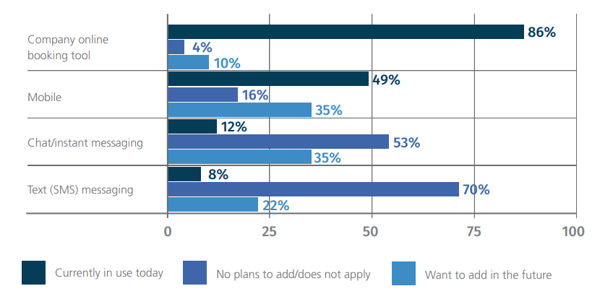

Ensuring employee safety on business trips is paramount.
With travel restrictions and health concerns in mind, businesses have adopted various strategies to continue operations while prioritizing employee safety.
Many companies have begun to use travel technology and adopted travel management software for comprehensive guidance on travel health and safety, promising a smoother travel experience.
Travel technology refers to the optimization of trip planning and automation of essential travel processes, including bookings, payments, and itineraries, for travel agencies and tour operators.
In this article, learn how businesses across various sectors can leverage travel technology to streamline their operations. Gain insights into the challenges they may encounter and discover effective solutions to overcome these hurdles
The impact of technology on travel has been transformative, simplifying and enhancing every aspect of the journey. From quick and effortless trip planning to instant bookings, technology has streamlined the process, saving time and effort for both travelers and travel agencies.
The accessibility of travel information through mobile devices has empowered travelers to stay organized and well-informed, ensuring a smooth and stress-free experience.
Moreover, technology has transcended language barriers, enabling effective communication and interaction in diverse locales. With the aid of translation tools and language apps, travelers can navigate foreign environments with confidence and engage more meaningfully with local communities.
Additionally, the integration of augmented reality (AR) has revolutionized the exploration of destinations, offering interactive and immersive experiences that enrich travel adventures. This amalgamation of technology with travel has not only made trips more convenient but has also fostered personalized and unforgettable experiences for each traveler.
As technology continues to advance, the future of travel promises even more innovative solutions, sparking anticipation for the endless possibilities that lie ahead.
The development of travel technology has led to significant changes in how we explore the world. From the early stages of basic reservation systems to today's sophisticated AI-driven platforms, technology has continuously evolved.
Let's take a look at its journey and current applications in the travel industry.
Collecting real-time data from airlines and hotels on their latest safety policies and pulling it into a desktop or mobile app can help travelers make better-informed decisions. A traveler will be able to easily see if his or her intended airline for an upcoming business trip is booking middle seats or not or taking other health and safety precautions in response to regional or world events.
Real-time data can also be used to provide a safety scorecard for a particular neighborhood to let travelers – and travel managers – know if there’s a virus outbreak or political or social unrest in a certain area, as well as the crime rate.
In addition, real-time employee data can be used to keep vulnerable demographics safe, such as a female arriving at a foreign destination after midnight. It can also recommend certain transportation means and hotel quality based on demographics.
Personal privacy certainly plays a role in this. Google and Apple are already busy at work finding ways to be able to notify a person that he or she may be near someone who was potentially exposed to an illness. In this way, you could avoid that person and situation in a private way that protects the other person’s privacy.
This type of technology may set a standard for the future if or when other highly contagious illnesses arise.
Artificial intelligence and its subsets, machine learning, and predictive analytics can work together to predict likely outcomes of various scenarios. They combine real-time and historical data from different sources to recognize patterns.
In this way, they can differentiate 'normal' from 'abnormal'. That information can then be used to alert travel managers to unusual activities so the managers, in turn, can safely assist with removing their travelers from those situations.
Tip: Empower your business travel management with cutting-edge AI software solutions.
AR and VR have recently regained attention. Could virtual and augmented reality also wield influence within the tourism industry in the years to come? Yes!
Virtual reality empowers individuals to embark on journeys to new destinations from the comfort of their own homes. Virtual tours will offer people a sneak peek of exotic locales before their actual visit, enhancing their travel planning experience.
Tip: Transform your employee travel training with immersive virtual reality tools.
Furthermore, leading travel platforms such as Booking.com have the potential to use augmented reality and introduce virtual previews of hotel rooms, allowing them to better align with customer expectations.
Tip: Equip your team with real-time visual guidance and enhance your business travel safety protocols with innovative augmented reality software.
A growing number of internet-based travel agencies and hotels are increasingly utilizing AI-driven solutions such as chatbots to automate reservations and deliver tailored customer service.
These automated systems not only ensure round-the-clock customer assistance but also facilitate bookings, furnish immediate responses to frequently asked questions, process transactions, and engage in intelligent, human-like dialogues.
They effectively serve as an indispensable travel companion. Armed with such comprehensive insights, online travel agencies (OTAs) and hotels can effectively present or dispatch pertinent offers to their clientele.
Embrace the transformative power of chatbots in your business operations. These AI-powered virtual assistants are the key to optimizing travel and streamlining communication processes. Explore the top picks:
*These are the five leading chatbot software solutions from G2's Fall 2023 Grid® Report.
People are ready to accept things that are more automated, such as automatically fixed trips when issues arise and automatically exchanged tickets without human intervention.
As technology continues to advance, travel managers will eventually be able to push a button to automatically get all of the company’s unsafe travelers home or to a safe place while adhering to company policies.
Similarly, when individual travelers feel unsafe, they’ll be able to push a button to be directed to a safer location – efficiently and without the friction of having to wait on the phone on hold. The travel management system will automatically generate an itinerary to bring the traveler home within policy. e
Another development in the travel industry is contactless travel. For example, cars connected via the Internet of Things (IoT) can be opened electronically with a smartphone – no key is needed.
Along those same lines, you’ll be able to use your smartphone to open your hotel room door without even turning the knob. Many hotels already use near-field communication (NFC) technology for this purpose.
All you have to do as a traveler is enter the hotel. The hotel’s technology then geolocates you, recognizes you, and confirms your credit card is on file. Then, the technology sends an update to the mobile app with your room number. You go to your room, hold the phone near the door, and the door opens.
Touchless interfacing technology is likely to extend to flight ticketing, identification verification, check-ins, purchasing, ordering food, and more.
In an attempt to keep travelers safe and in compliance with company policies by specifying what is or isn’t allowed (and tracking travelers throughout their journey), companies employ approved online booking tools (OBTs).
Most OBTs are connected to a global distribution system (GDS), which aggregates and distributes content from travel industry service providers such as airlines, hotels, car rental companies, and railways.
The OBT then serves this content to travelers so they can search, book, and manage all aspects of their trip at once. Additionally, some OBTs can connect with content sources, such as safety and risk rating providers, to offer specific content that may not be otherwise available, enabling even greater choices for travelers.
of survey respondents prefer to look for a better price on their own rather than booking through the OBT, believing they can save more money.
Employees are expected to book their business trips through the company’s approved OBT because doing so ensures travel managers can keep track of and communicate with their employees. However, compliance has been a long-standing issue when it comes to business travel.
Many travelers don’t use the OBT because they think they can get a better price elsewhere, they don’t like the user experience of the tool, they believe it lacks functionality in the native app (mobile), or they worry about receiving their loyalty points.
If travelers aren’t using the tools provided to them, which are designed to protect both business travelers and travel managers, it’s harder to keep travelers safe.

Source: Booking Tools and Technologies Report
Add to that the fact that the most commonly used corporate travel software is largely designed based on expense report needs, and you have a system that’s ready, even past due, for transformation. Road warriors, those business travelers who spend much of a year traveling for business, really should be involved in the software creation process as they can tell better than anyone what would be helpful to them.
Unlock the potential of travel and expense management software to automate expense tracking and travel reimbursement processes, significantly reducing the burden of manual paperwork. Explore the top picks:
*These are the five leading travel and expense management software solutions from G2's Fall 2023 Grid® Report.
Why couldn’t the travel booking experience be more like the consumer experience when buying other items online? If, for example, you buy something from Amazon and want to return it, you can do so with the touch of a button.
In the corporate travel industry, however, if you want to change a flight or a hotel booking, you will most likely need to call the airline or hotel and wait on hold for up to an hour before you can speak to someone to handle that request. You also may be charged a change fee.
This cumbersome process is inhibiting the use of approved booking platforms with itinerary management capabilities, thereby making it much more difficult for companies to provide the duty of care for their travelers. It shouldn’t be this way.
In an effort to encourage compliance with corporate policies and to ensure the safety of travelers, travel solution companies are stepping up with new technology offerings:
This enables travel managers to communicate with and/or reroute travelers as needed to keep them safe from natural disasters and other phenomena. These are only a handful of examples. Other technologies are evolving as well.
Before these technology advancements can really take off and help make travelers safer, the discrepancy between the technology experience in everyday life and the one business travelers encounter must be addressed.
It’s no secret that technology has removed friction from the consumer shopping experience. The touch of a button (and the run of a credit card) can initiate the shipping of a package to a personal address.
Unlike that simple, straightforward practice, however, the travel sector relies on people in the middle, so to speak, to facilitate all the details of a travel booking, from a flight to a rental car and even a hotel room.
Today’s business travelers want that same streamlined, efficient experience in travel that they’ve come to expect in their personal lives. So, how can we improve the way business travel is carried out to create that frictionless experience and ensure traveler safety at the same time? It needs to start with the travel solution providers.
“We as vendors need to think about a traveler-centric view, not an expense report-centric view or a finance-centric view or a centered view around the non-road warrior,” Rizzo, a road warrior of 35 years.
As technology continues to advance and improve, travelers will naturally adopt those that are simplest to use, that is, the ones that provide the least amount of friction.
of business travelers are looking forward to getting back to business travel when safe.
Source: AMEX Global Business Travel
Businesses are assessing when they’ll be able to afford to put people on the road again, while FCM Travel Solutions found that 88% of business travelers will consider it safe to return to travel if their companies believe it’s safe.
Travel managers must also make some changes. Those involved in the decisions about which software to purchase and use will need to broaden their view to ensure the solution will also satisfy the needs of travelers and not just the needs of the business.
History proves that to be true as well. The tragedy of 9/11 led to the development of an infrastructure for metal detector scanners. The severe acute respiratory syndrome (SARS) outbreak of 2003 prompted the implementation of thermal scanners in Asia.
“Unfortunately, COVID has had a devastatingly negative effect on the world, but it's forced a lot of new thinking on travel,” Rizzo says. Indeed, recent events have led to even better ways to keep business travelers safe and to provide an intuitive travel experience.
It’s also created an opportunity for travel solution providers and travel management companies to consider what the optimal business travel platform should look like and how it can make road warriors more efficient and safer.
It will be a slow process as companies approach it cautiously. However, as technological advancements occur exponentially, it won’t be long before we have even more technological solutions to our most pressing health and safety issues.
Enhance your business travel experience with the leading expense management software equipped with advanced itinerary management capabilities.

Control costs and enhance efficiency with the best travel management software.
Lana Gates has been writing about technology for more than 25 years. When not writing or editing, she can be found traveling or playing word games on her phone.

Control costs and enhance efficiency with the best travel management software.
What is end-to-end encryption? End-to-end encryption (E2EE) is a popular, secure...
 by Alyssa Towns
by Alyssa Towns
Developing software applications is a complex activity.
 by Aaron Walker
by Aaron Walker
Encrypting a whole disk isn't enough when you aim for robust data security.
 by Sagar Joshi
by Sagar Joshi
What is end-to-end encryption? End-to-end encryption (E2EE) is a popular, secure...
 by Alyssa Towns
by Alyssa Towns
Developing software applications is a complex activity.
 by Aaron Walker
by Aaron Walker
Never miss a post.
Subscribe to keep your fingers on the tech pulse.



